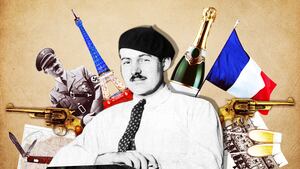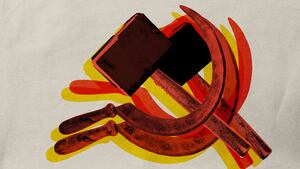PARIS—In the summer of 1954, John Steinbeck was living the good life here in the City of Lights, but teetering on the brink of darkness and despair. The author of The Grapes of Wrath was hugely famous and comfortably rich (although still years away from the 1962 Nobel Prize for Literature), but he was wrestling with depression. “I just don’t have any place to run to, it seems sometimes,” he wrote to his agent in New York.
Writers often like to complicate their lives with distractions and adventures when they’re depressed, especially when they think they’re not writing anything very important, which was the case with Steinbeck in the summer of ’54. So, to keep himself amused, Steinbeck had signed up for a series of little columns and short stories to be published in French (which he did not speak) in the Paris daily Le Figaro.
And one of those has just been published in English for the first time by The Strand Magazine, which previously unearthed lost or forgotten fiction by Ernest Hemingway, H.G. Wells, and others.
Also, during that Paris sojourn in ’54, it appears Steinbeck was working as an asset gathering intelligence for the CIA.

So there are some intriguing mysteries about what Steinbeck was thinking, writing, and actually doing that summer as he settled in with his third wife, Elaine, and his two young boys from his second marriage, Thomas and John IV.
The opulent apartment they rented was at 1 Avenue de Marigny in a palace next door to one of the Rothschilds’ mansions and across the street from the Élysée, the French presidential residence. One could walk to the U.S. embassy next to Place de la Concorde or the U.S. ambassador’s residence on the Faubourg St. Honoré in 10 minutes or less.
The Steinbeck apartment was also so close to the venerable restaurant Laurent that on a quiet summer evening one might have heard the pop of Champagne corks on its terrasse, providing partial inspiration for the newly published short story, which came out originally under the title “Les Puces Sympathiques” and, now, “The Amiable Fleas.”
The restaurant that bears that rather unsympathetic name in Steinbeck’s tale is a blend of clichés. Like Laurent today it has one Michelin star, and the chef certainly hopes for another. But it is also home to resident intellectuals of the sort one might easily have found across the river back then at the Flore, the Lipp, or Les Deux Magots (which means two wise men but is sometimes referred to by Anglophones as The Two Maggots).
At Steinbeck’s imagined café, “Three of its outside tables had as daily ornaments: One poet whose work was so gloriously obscure that even he did not understand it; one architect whose fame rested upon his passionate attack on the flying buttress; and a painter who worked in invisible ink. Each of these of course drew his followers, so that The Amiable Fleas was beginning to be mentioned by the conductor of passing tourist busses.”
The chef has a cat, a feline muse named Apollo to whom he gives a taste of all his sauces. But when the Michelin critic comes, the chef is so tense and out of sorts he kicks the cat, which slinks away into the wilds of Paris. The meal for the critic is a disaster and all seems lost. The chef, acknowledging defeat, and hoping at least to reconcile with the cat, makes a special dish with a very special secret ingredient and goes searching for the errant feline. By happenstance, the critic winds up back at the restaurant and samples the dish and voilà—it’s like the ratatouille moment in the movie Ratatouille (made many decades later), a story for children written with light-hearted asides for adults and a happy ending.
As we can read in Steinbeck: A Life in Letters, on June 12, 1954, Steinbeck had taken his younger son, nicknamed “Cat,” for his eighth birthday dinner “on the Eiffel Tower as he had requested.”
“I had no sleep in me later so sat up and wrote a Figaro piece and part of another,” Steinbeck wrote to his agent, Elizabeth Otis, before talking about his depression and his gratitude to his psychologist, who had sent him a letter telling him a little of what to expect from his mood swings. He would keep working on the Figaro pieces, he said.
That same week, Steinbeck wrote a tribute to his great friend, the war photographer Robert Capa, who had just been killed in Vietnam. He wrote a travel piece about why he loved the Île de la Cité, home to Notre Dame Cathedral, and about fishing on the banks of the Oise river, so beloved of the Impressionists. He was trying to be optimistic. But when “Les Puces Sympathiques” came out in Le Figaro on July 31, it was a children’s tale that opened with the author’s frustrations and fears of inconsequentiality.
“I am sometimes criticized for avoiding the great discordant notes of the times and closing my ears to the drums of daily doom,” Steinbeck begins. “But I have found that the momentary sound very shortly becomes a whisper and the timely fury is forgotten, while the soft verities persist year after year.” The French war in Indochina was coming to its grim conclusion after the final defeat at Dien Bien Phu in May that year. “England and America rock in the tempest and perhaps behind [his] iron bed curtains the Soviet too has nightmares. Suppose I were to write of these important matters! By the time my piece were printed all would be past and much of it forgotten and there would be new earthquakes.”
If Steinbeck was indeed writing about “important matters,” or at least talking about them that summer, his contacts in the CIA were ready to listen.
We know for certain that before Steinbeck took a months-long tour of the Mediterranean region two years earlier, he volunteered for such serious work in a letter to then-Director of Central Intelligence William Bedell “Beetle” Smith: “If during this period I can be of any service to yourself or to the agency you direct, I shall be only too glad.”

And we know from Smith’s response, available in the CIA’s online archives, that Steinbeck’s offer was welcomed. We also know from KGB archives that when Steinbeck visited the Soviet Union in 1947, the Soviet spooks suspected he might use his prestige and contacts to discredit the USSR or spy on it. (One of Steinbeck’s first visits on that trip, as it happened, was to the U.S. ambassador in Moscow at the time, the same William Bedell Smith who took over the CIA in 1950 and built it into an effective organization.)
Steinbeck’s celebrity gave him access to important people all over the world, and for a time his powerful narratives of poverty in America during the 1930s had made him a darling of the left. His books were widely printed by the Soviets. Indeed, although he worked for the Office of War Information (the propaganda arm of the OSS intelligence agency during World War II) the Army’s intelligence operation would not clear him for a commission because of suspected communist sympathies.
Steinbeck was in fact quite hostile to Soviet totalitarianism, but the late 1940s and early 1950s were the era of McCarthyism. Anti-communist witch hunts dragged many of Steinbeck’s friends and associates in front of the House Un-American Activities Committee, where they were expected to denounce others, or be doomed to blacklists and perjury trials. Whether a CIA connection helped Steinbeck avoid such an ordeal is not clear, but he was never called.
Thanks to the research of author Brian Kannard, whose Freedom of Information Act requests surfaced the Steinbeck-Smith correspondence half a dozen years ago, we also know that Steinbeck’s older son, Thomas, suspected something strange was going on that summer of ’54 in Paris even though he was only 10 years old at the time.
Thomas “clearly recalls that every few days, someone from the United States Embassy would drop off an attaché case for John,” Kannard wrote in his 2013 book Steinbeck: Citizen Spy. “This case was then picked up a day or so later by a member of the embassy’s staff. This practice was kept up throughout their Parisian adventure of 1954. A young Thomas was not privy to what these communications were, but the transactions are suspicious.”
No kidding. But Thomas, who died in 2016, was remembering all this when he was in his late sixties, often calling Kannard late at night and well into his cups. More intriguing was what Kannard turned up in the FBI files on Steinbeck, which also are available to the general public:
“On March 10, 1954”—which is to say just before Steinbeck went to Paris—“the FBI would generate a fact sheet on Steinbeck to an unknown recipient. This eight-page document contains three paragraphs redacted ‘per CIA’ under FOIA exclusions b1 (national-security reasons) and b3 (information exempt under other laws). Furthermore the reference slips following the March 10th document include file reference numbers with prefixes for espionage and treason.”

The timing of the report, the reference files and the subsequent redactions give, in Kannard’s view, “a strong indication that the Agency was performing a routine check on Steinbeck before he ventured out into the field once again.”
As often happens when non-academics wander into the groves of the tenured tribes, Kannard was disappointed to find his research largely ignored. Probably it did not help that he brought the book out through his own company, Grave Distractions Publications, and one of his previous titles was Skullduggery: 45 True Tales of Disturbing the Dead. "The Amiable Fleas" probably will get more press. But at least one scholar, writing in Pennsylvania State University’s Steinbeck Review argued that Kannard’s “book about Steinbeck’s role as a ‘passive intelligence-gatherer’ for the United States Central Intelligence Agency makes a compelling case that… deserves to be taken seriously.”
What is missing is conclusive evidence that Steinbeck ever actually provided any useful secret information. Celebrity spies in those days were not known to be great producers, as the Soviets found out when they recruited Ernest Hemingway.
But that is another little story with different secret ingredients.



